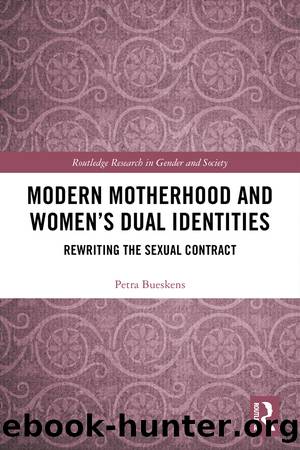Modern Motherhood and Women's Dual Identities by Petra Bueskens

Author:Petra Bueskens [Bueskens, Petra]
Language: eng
Format: epub
Tags: Social Science, General, Sociology
ISBN: 9781317195450
Google: iX1aDwAAQBAJ
Publisher: Routledge
Published: 2018-05-31T03:38:32+00:00
Employment
The increase of womenâs participation in the labour force has been a major change over the past forty years in western societies, dramatically altering the terms of the sexual contract. Using Australian data, we see that the participation rate of women11 has risen from 29 per cent in 1954 (comprised of largely unmarried women) to 66 per cent in 2016â17 for those aged 20â74 (Campbell & Charlesworth, 2004, pp. 5â6; ABS, 2017). The most dramatic increases have occurred among married women who previously left the workforce to care for their families. The Office of the Status of Women provides five reasons for this monumental transition including: (1) increased school retention rates and participation in tertiary education and training; (2) changes in the nature of work which include growth in female-dominated industries and occupations, as well as a greater availability of part-time and other flexible working arrangements; (3) the availability of childcare services; (4) the introduction of anti-discrimination legislation and equal remuneration legislation (in particular the introduction of the equal pay act and the abolition of the basic wage system in 1972, the Sex Discrimination Act 1984 and the Affirmative Action (Equal Employment for Women) Act 1986); and (5) changing societal values regarding womenâs roles (Australian Government, 2007). More recent changes, such as the Fair Work Act 2009, which introduced a formal right for employees to request flexibility, and a national system of paid parental leave in January 2011, have additionally supported womenâs labour force participation.
It is clear that in the past forty years changes in the production process, specifically the decline in manufacturing and the rise in service-based industries, have favoured womenâs entry into paid employment. Together with more egalitarian attitudes and equal opportunity legislation, women have experienced an historic shift out of their homes and into the labour market. This increase in womenâs participation has also been paralleled with a decrease in menâs participation. For example, the labour force participation rate for men has declined from 81.4 per cent in 1978 (Campbell & Charlesworth, 2004, p. 4) to 78 per cent in 2016â17 (ABS, 2017). Moreover, the proportion of men in full-time work has also declined over this period with more working casually and part-time (ABS, 2017). These figures are consistent for comparison countries (Blau, 2012; Pfau-Effinger, 2017).12 As a result, the gap between menâs and womenâs labour force participation is closing.
However, when this working profile is broken down some salient features emerge. First, the largest growth in female employment since the 1970s has been among married mothers working in part-time jobs. Second, more female employees were employed part-time. In contrast, only 8.4 per cent of fathers with a young child worked part-time (OECD, 2018). The figures show that women typically change their employment status from full-time to part-time when they become mothers, although this is more pronounced in Australia and the UK than elsewhere (ABS, 2006; WGEA, 2014).
This can be ascertained by disaggregating the employment figures according to age. Moreover, we can also see how this pattern has shifted over the last forty years with womenâs increasing individualisation.
Download
This site does not store any files on its server. We only index and link to content provided by other sites. Please contact the content providers to delete copyright contents if any and email us, we'll remove relevant links or contents immediately.
Should I Stay or Should I Go? by Ramani Durvasula(7571)
The Lost Art of Listening by Michael P. Nichols(7412)
The Rosie Project by Graeme Simsion(6210)
Beartown by Fredrik Backman(5609)
We Need to Talk by Celeste Headlee(5547)
Ego Is the Enemy by Ryan Holiday(5298)
Hunger by Roxane Gay(4869)
Suicide Notes by Michael Thomas Ford(4766)
I Love You But I Don't Trust You by Mira Kirshenbaum(3812)
Mummy Knew by Lisa James(3637)
Not a Diet Book by James Smith(3342)
Crazy Is My Superpower by A.J. Mendez Brooks(3335)
Toxic Parents by Susan Forward(3233)
Girl, Wash Your Face by Rachel Hollis(3211)
The Complete Idiot's Guide to Coping With Difficult People by Arlene Uhl(3118)
Name Book, The: Over 10,000 Names--Their Meanings, Origins, and Spiritual Significance by Astoria Dorothy(2943)
The Social Psychology of Inequality by Unknown(2943)
The Hard Questions by Susan Piver(2928)
The Gaslight Effect by Dr. Robin Stern(2740)
